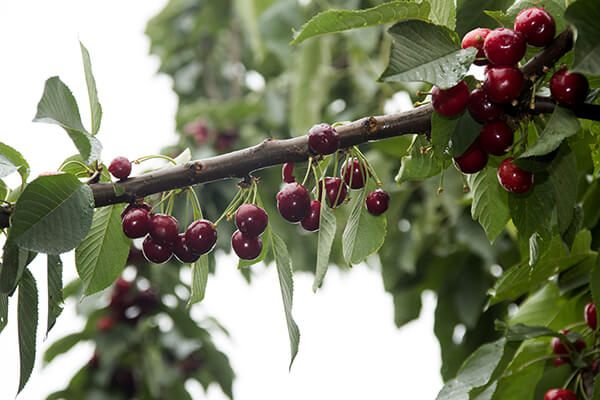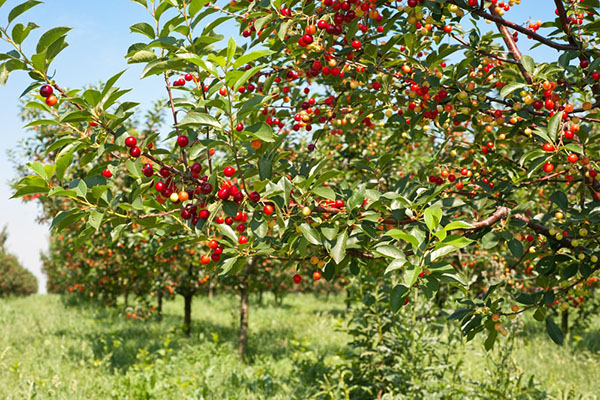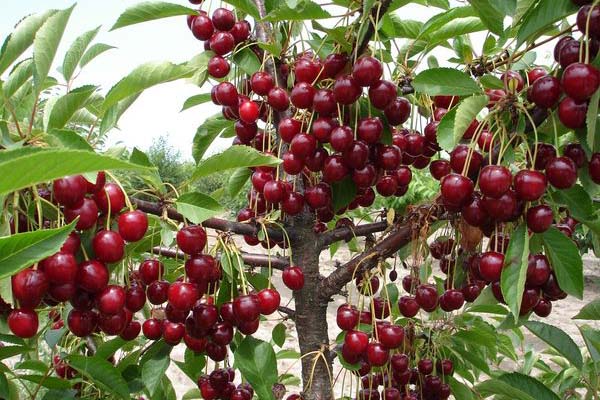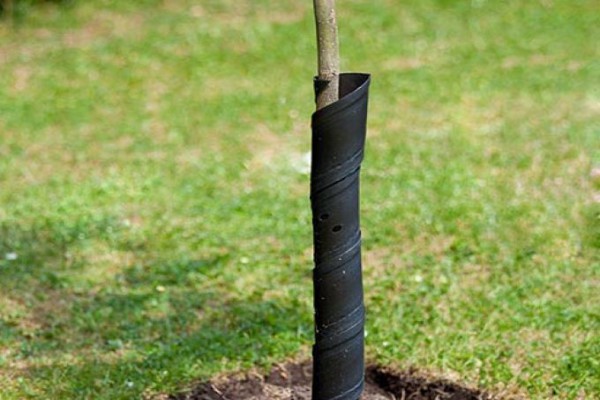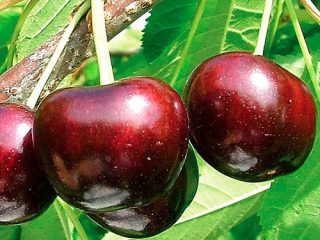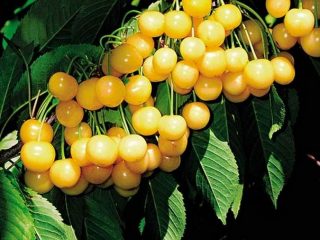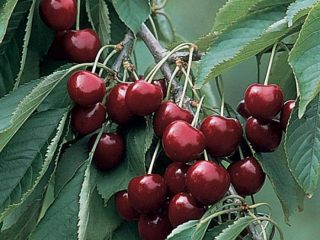Content
Cherries Leningradskaya Black is a reliable variety that bears fruit even in harsh conditions. When the rules of planting and care are followed, the tree bears fruit for a long time and abundantly.
Breeding history
Leningradskaya Black was bred at the Pavlovsk Experimental Station in St. Petersburg. When working on the variety, increased attention was paid to its winter hardiness. This is one of the first cherries that are highly resistant to freezing.
Description of culture
This is a medium late ripening variety. The tree has a spreading crown with elongated green leaves. Tree height y cherries Leningrad black reaches 3-4 m.
Description of the sweet cherry variety Leningradskaya black:
- fruit weight from 3 to 4 g;
- wide-heart or round shape;
- dark red skin;
- when ripe, the fruits acquire a rich dark color;
- juicy burgundy pulp;
- sweet spicy taste with mild sourness;
- the stone is medium in size, partially separated from the pulp.
The evaluation of the tasting properties is 4–4.2 points.
Sweet cherries are tied in bunches. After ripening, the fruits stay on the branches for a long time and do not crumble.
Sweet cherry Leningradskaya is recommended for cultivation in the Central part of Russia and the southern regions of the North-West region.
Characteristics
Before purchasing a cherry seedling, the characteristics of the variety are assessed: resistance to heat, winter frost, flowering and ripening time, harvest volume.
Drought resistance, winter hardiness
Leningradskaya is characterized by average drought tolerance. In the absence of rain, the tree is watered during flowering and at the beginning of the ripening of the crop. Stagnant moisture is detrimental to the culture.
High frost resistance of Leningrad black cherries. The tree tolerates the winter frosts typical for the Northwest region.
Pollination, flowering period and ripening times
Sweet cherry is a self-fertile culture. To form the harvest, trees are planted in groups. Pollinators for Leningrad black cherries are chosen taking into account the flowering period.
The best varieties for pollination:
- Iput;
- Tyutchevka;
- Fatezh;
- Jealous;
- Bryanochka;
- Michurinka;
- cherry Leningrad yellow or pink.
Other varieties of Leningrad varieties also have high winter hardiness and productivity.
According to the description of the variety, the Leningradskaya yellow cherry has a good taste, bright amber color and ripens at a later date.
Leningrad pink bears fruit earlier than yellow, its fruits are sweet, yellowish with a blush.
The flowering of Leningradskaya black cherries occurs in the middle period - early or mid-May. The fruits are harvested from late July to September.
Productivity, fruiting
The yield of the Leningradskaya black cherry variety is stable from year to year. Fruiting is extended over time, so the harvest is harvested in several stages. So that the shoots do not fall under the weight of the fruit, props are installed.
Cherry Leningradskaya black bears fruit for 3-4 years after planting.30-40 kg of fruits are removed from each tree.
Scope of berries
Sweet cherries are suitable for fresh consumption, desserts and fruit platter. The fruits are suitable for freezing and homemade preparations: jam or compote.
Disease and pest resistance
The variety is resistant to diseases and crop pests. Constant care and preventive spraying help to avoid the spread of diseases and insect attacks.
Advantages and disadvantages
The main advantages of the variety:
- frost resistance;
- decent fruit taste;
- stable fruiting;
- low trunk, which simplifies maintenance and harvesting;
- early fruiting.
Before planting, take into account the disadvantages of the variety:
- planting of a pollinator is required;
- sensitivity to lack of moisture.
Landing features
Correct planting is the key to successful cultivation of Leningradskaya black cherries. Particular attention is paid to site selection and soil preparation.
Recommended timing
In cold climates, cherries are planted in the spring, before the sap begins to flow. In the southern regions, they are waiting for the end of the leaf fall.
Choosing the right place
For culture, southern areas, flat or with a slight slope, are suitable. Cherries should not suffer from cold, strong winds. The culture is provided with constant natural light.
The culture prefers light, fertile soil in which moisture does not stagnate. Leningradskaya develops best in sandy loam and loamy soil. River sand is added to heavy clay soil. To avoid stagnation of moisture, a drainage layer is laid.
What crops can and cannot be planted next to cherries
- Cherries are removed from apple, apricot, plum and other stone fruit trees by at least 5 m.
- Cherry, mountain ash, grape or hawthorn are placed next to the crop.
- Alfalfa, phacelia, and other melliferous plants planted under the tree attract pollinating insects.
- Leningradskaya does not tolerate the neighborhood with eggplants, tomatoes and peppers. These crops are susceptible to similar diseases and pests.
- Cherries are also placed away from raspberries, gooseberries, currants and sea buckthorn.
Selection and preparation of planting material
Saplings are purchased in nurseries or proven garden centers. For planting, choose a one- or two-year-old material with a healthy trunk and shoots.
If the roots of the tree are dried, they are immersed in water for 2-10 hours. To increase the survival rate of the seedling, you can add 2-3 drops of the Kornerost stimulant.
Landing algorithm
Planting culture:
- First, a hole is dug on the site with a diameter of 1 m and a depth of 70 cm.
- Compost, 1 kg of wood ash, 200 g of superphosphate and 40 g of potassium salt are added to the fertile soil.
- Part of the prepared soil is poured into the pit and left to shrink.
- After 2-3 weeks, a seedling is prepared, its roots are straightened and placed in a pit.
- The roots are covered with soil, which is compacted and watered abundantly.
Follow-up care of the culture
A cherry tree needs watering 3 times per season: before flowering, in mid-July and late autumn before sheltering for the winter. 2 buckets of warm, settled water are poured under the tree.
Top dressing of the culture is carried out annually according to the scheme:
- in May, a mineral complex is introduced into the soil: 20 g of urea, potassium salt and superphosphate each;
- after removing the fruits, fertilizers based on potassium and phosphorus are reintroduced.
Shoots are pruned annually to form a crown and increase yields. The procedure is performed in the spring, before the buds swell, or in late autumn. Be sure to eliminate dry and frozen shoots.
The Leningradskaya black variety has high frost resistance. Winter protection is needed only for young plantings. They are covered with agrofibre and spruce branches.It is better to refuse the use of polyethylene and other materials that do not allow air to pass through.
In the spring, when the snow melts, the material is removed. To prevent rodents from damaging the cherry trunk, a special mesh or roofing material is attached to it.
Diseases and pests, methods of control and prevention
The most dangerous diseases of sweet cherry are indicated in the table:
Name | Symptoms | Ways to fight | Prophylaxis |
Clasterosporium disease | Brown spots on the leaves with a dark border. As a result, the leaves fall prematurely, the fruits dry out. | Removal of affected parts, spraying trees with a solution of copper sulfate. | · Spraying in early spring with Nitrafen solution. · Removal of dry leaves. |
Moniliosis | Leaves, flowers and fruits dry out before time. | Sick shoots are cut out. The tree is sprayed with Bordeaux liquid. |
Cherry pests and methods of dealing with them are indicated in the table:
Name | Signs of defeat | Ways to fight | Prophylaxis |
Aphid | Aphid larvae feed on the sap of tree leaves. As a result, the leaves are deformed, the yield of the tree decreases. | Treatment of shoots with the drug "Confidor". |
|
Cherry fly | Larvae damage flowers and fruits. | Spraying with Actellik solution. |
Conclusion
Cherry Leningradskaya black - a well-known variety for dessert purposes, adapted to Russian conditions. When planting crops, take into account the presence of pollinators, soil composition and illumination. Preventive spraying will help protect the tree from diseases and pests.
Testimonials
Video review of Leningradskaya black cherry:
